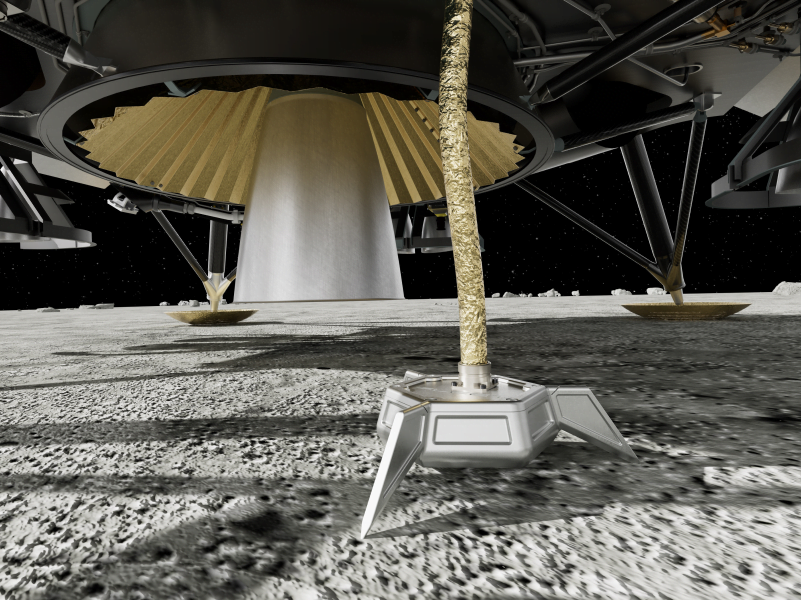Fleet Space Technologies’ equipment will land on the moon in 2026 after the South Australia-based company struck a launch agreement with a Texas-based orbital vehicle operator.
The Australian company’s spider-shaped device will capture seismic readings after hitching a ride alongside NASA and European Space Agency payloads, and mark the first time Australian seismic technology has been to the moon.
Fleet’s Seismic Payload for Interplanetary Discovery, Exploration and Research (SPIDER) technology will fly on board Firefly Aerospace’s Blue Ghost lunar lander in what will be the US company’s second lunar mission, and Fleet’s first.

Fleet was awarded a $4 million grant through the Australian Space Agency’s Moon to Mars: Demonstrator Program in June to support development of SPIDER and prepare it to collect seismic data from the Moon’s South Pole.
The moon mission will focus on examining the mineral profile of the surface and to search for water ice deposits. The data will be helpful in determining if there are sufficient resources to support lunar infrastructure or further exploration of the moon’s surface.
According to Fleet, SPIDER leverages advances in Ambient Noise Tomography (ANT). The device will “record the natural seismic waves in the Moon’s subsurface continuously for 14 days”. The seismic station can operate on just one-watt of power.
When the SPIDER payload is delivered, it will remain tethered to the Firefly’s Blue Ghost lunar lander which will provide ongoing power and communications, enabling data collection and transmission.
The Blue Ghost lunar lander will be launched into lunar orbit alongside the European Space Agency’s Lunar Pathfinder satellite by Firefly’s Elytra orbital vehicle. Blue Ghost will then land on the far-side of the moon to deploy SPIDER alongside NASA’s LuSEE-Night radio telescope.
Firefly said the mission has been facilitated by NASA’s Commercial Lunar Payload Services initiative. The firm received a US$112 million contract from NASA to deliver the research payloads in March and has since completed a preliminary design review for the mission to the far side of the moon.
Fleet co-founder and chief exploration officer Matt Pearson said Fleet’s technology will be the first Australian tech to land on the lunar surface.
“Humanity is on the brink of making tremendous strides in our scientific understanding of the lunar regolith – [material layers beneath the surface] – by using advanced seismic technologies to acquire deeper insights about the Moon’s subsurface. Technologies, like SPIDER, will become key enablers of our long-term efforts to sustain life on the Moon and beyond,” Mr Pearson said.
“Fleet is honored to contribute our groundbreaking passive seismic technology to advance research that will enable the development of permanent infrastructure capable of supporting human life on other worlds.
“As the first Australian seismic technology to land on the Moon, we’re proud to take the first step of Australia’s Seven Sisters mission to explore the Moon and Mars in alignment with NASA’s Artemis program.”
The Seven Sisters mission is a Space Industry Association of Australia led initiative that was established to complement the US-led Artemis Moon to Mars mission.
Sensor and robotics company Advanced Navigation expects to be the first Australian company to reach the moon, with its technology to be onboard a NASA Artemis orbital mission expected in 2024 and onboard lunar landers by 2025.
Fleet raised $50 million in May through an oversubscribed funding round led by venture capital firm and existing investor Blackbird Ventures. They were joined by Mike Cannon-Brooke’s Grok Ventures, Alumni Ventures, superannuation fund Hostplus, TelstraSuper, Bondi Partners/The 1941 Fund, and Pavilion Capital.
Fleet also has a $6.4 million contract with Australia’s Defence Space Command to deliver its commercial satellites for use in the development and demonstration of a Low Earth Orbit satellite communications system. This was the firm’s first Defence contract.
Do you know more? Contact James Riley via Email.

